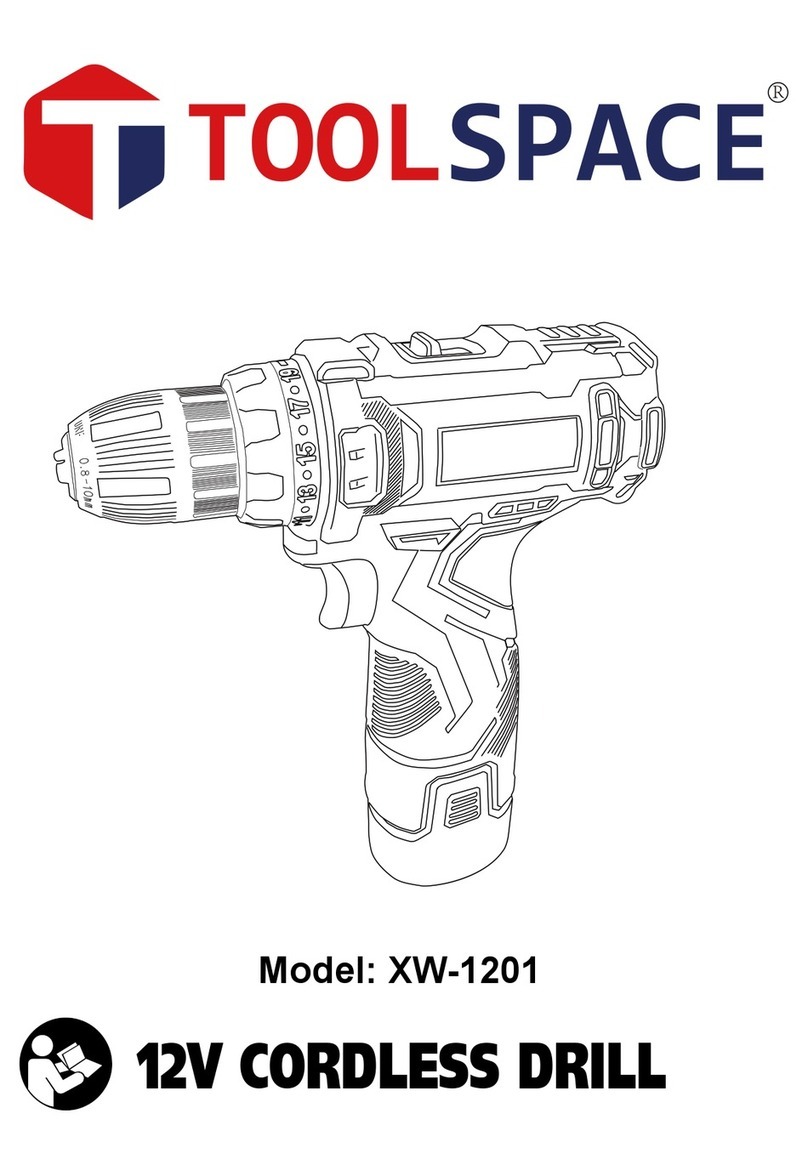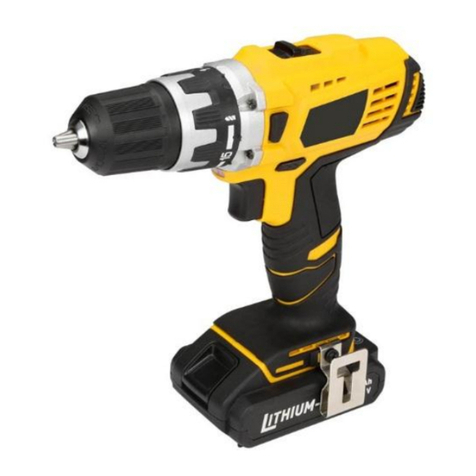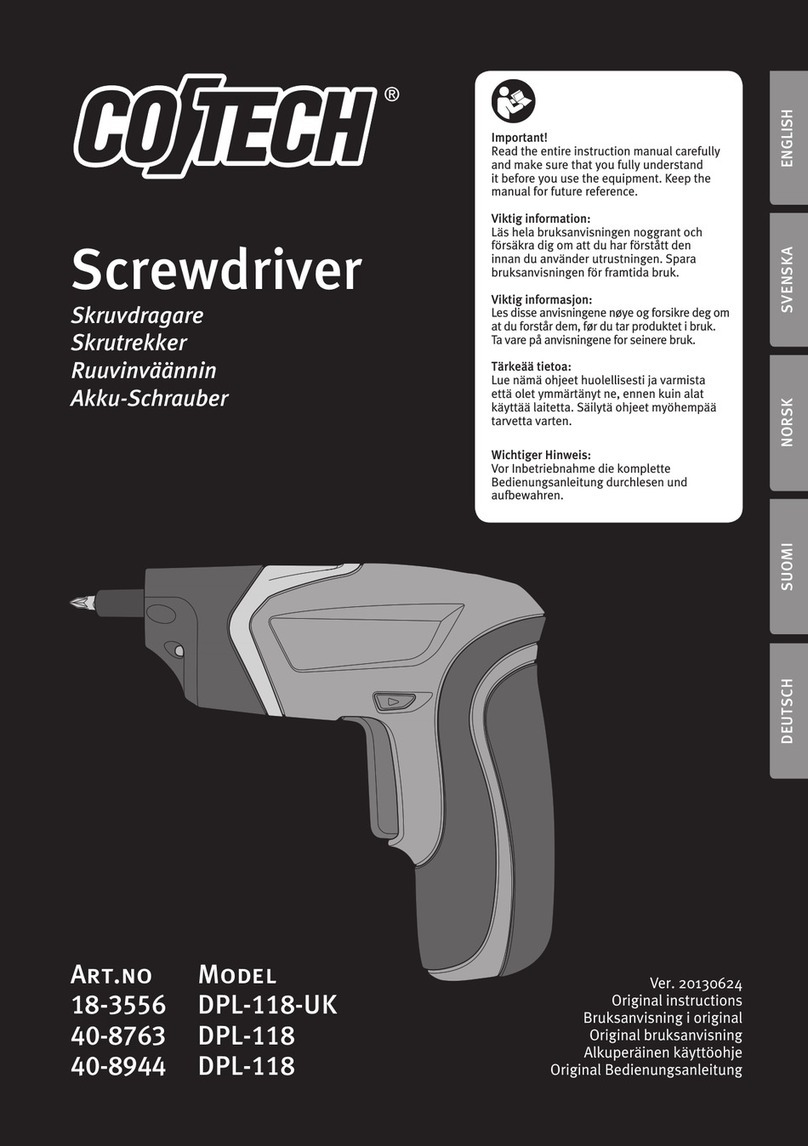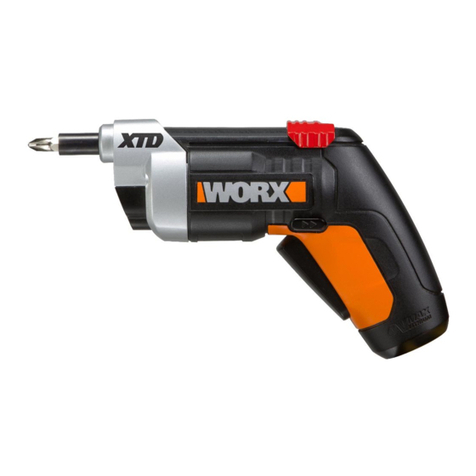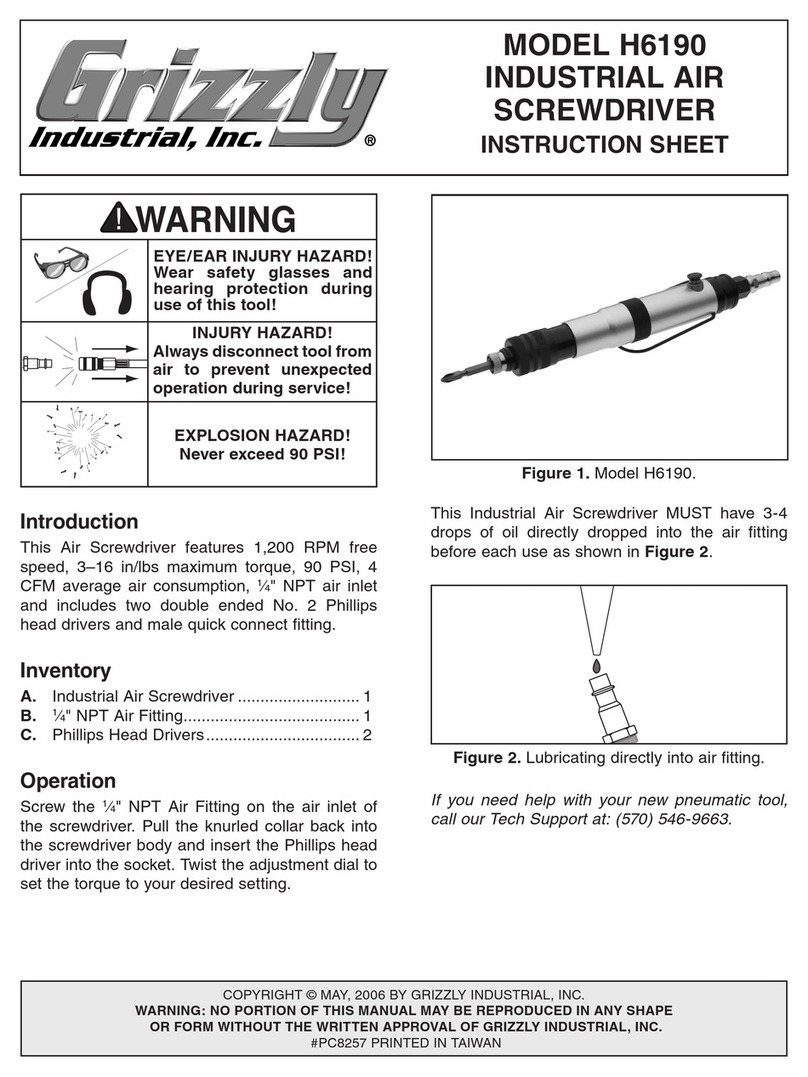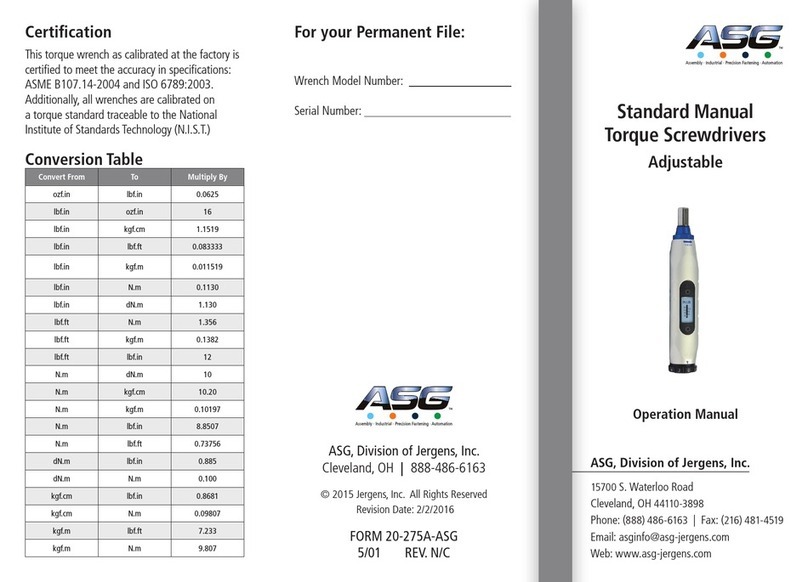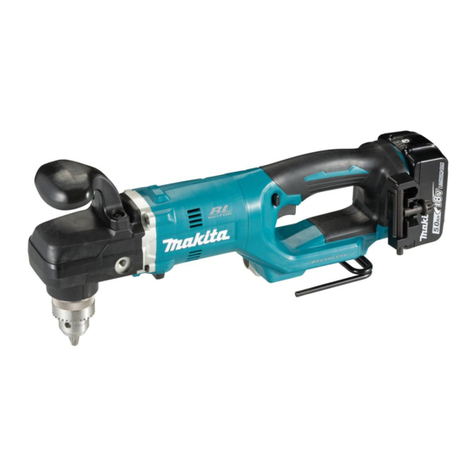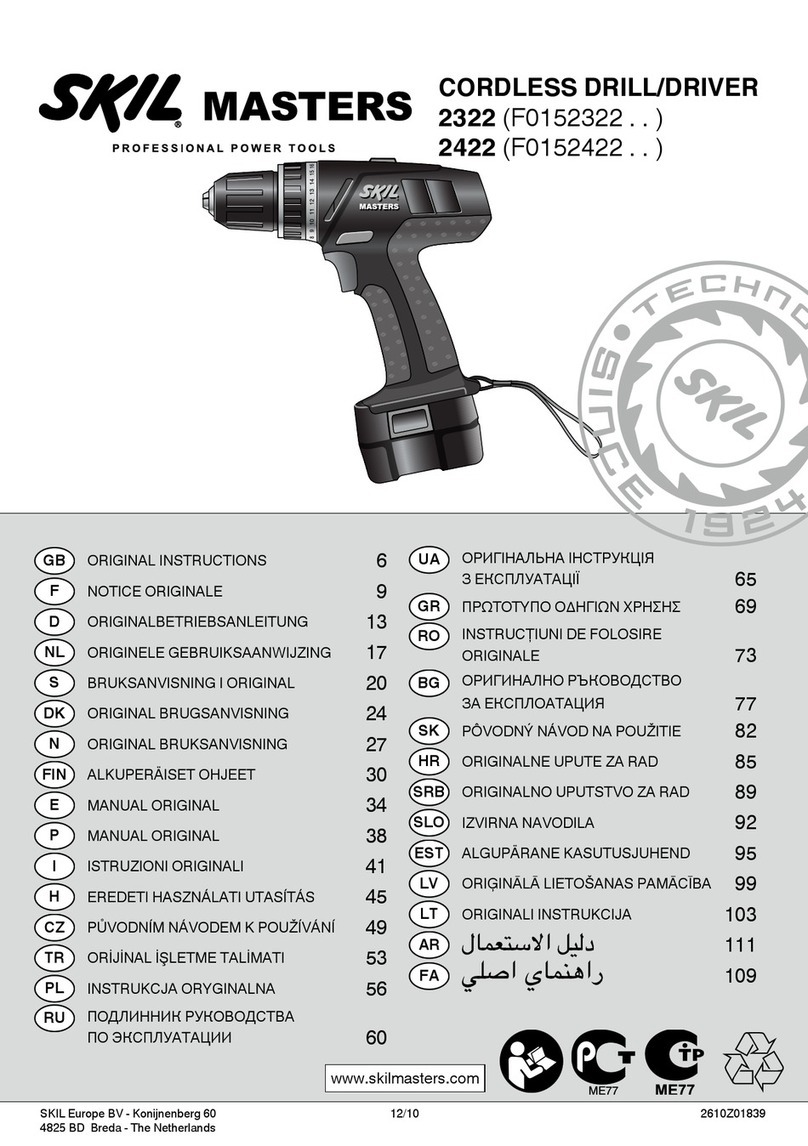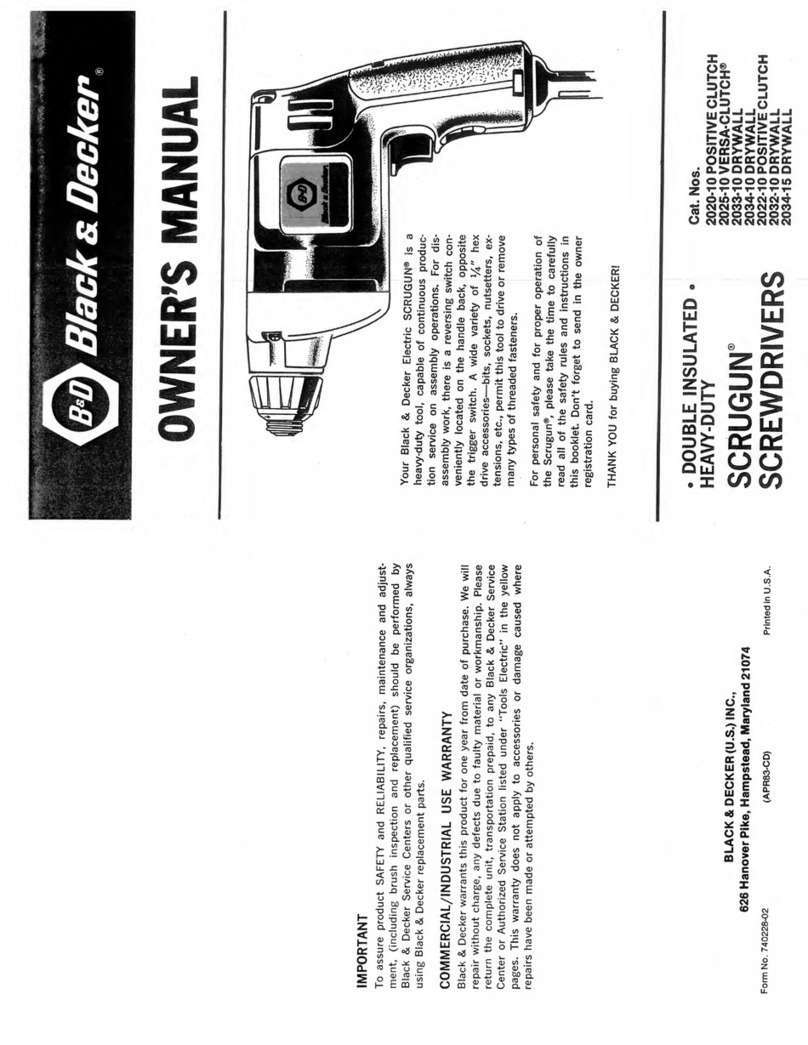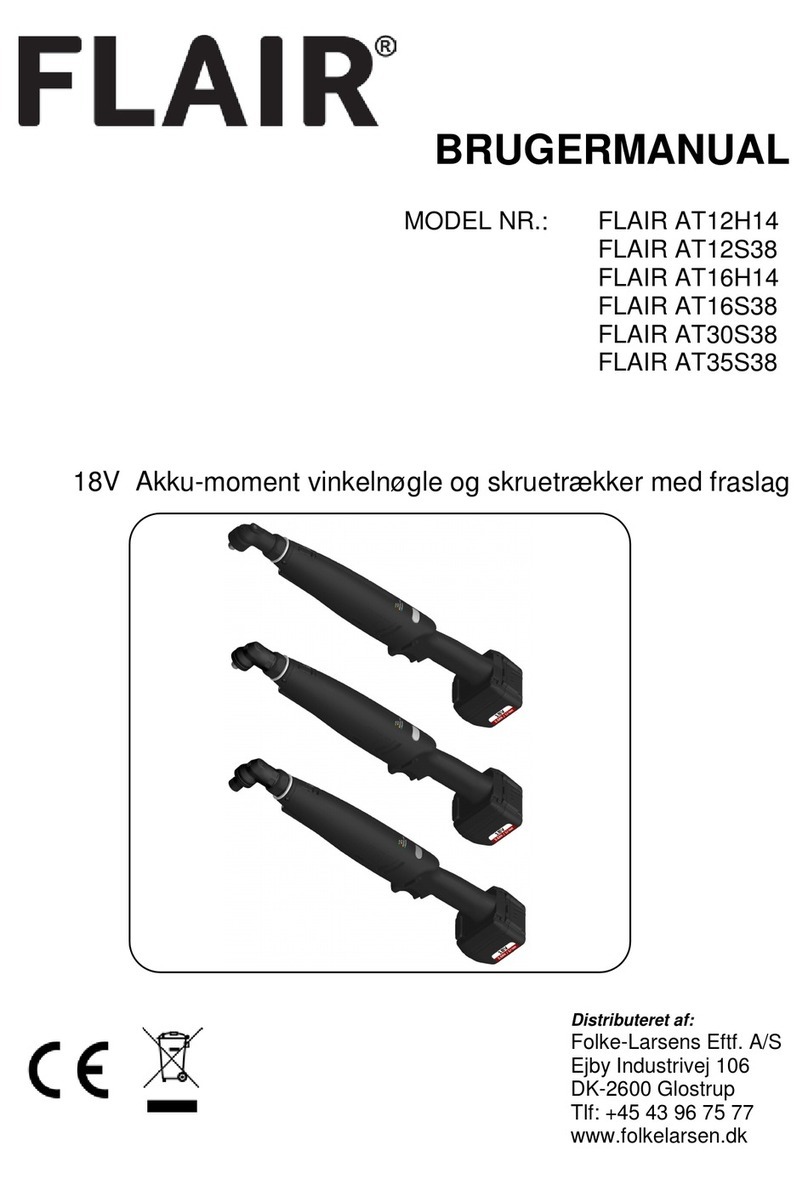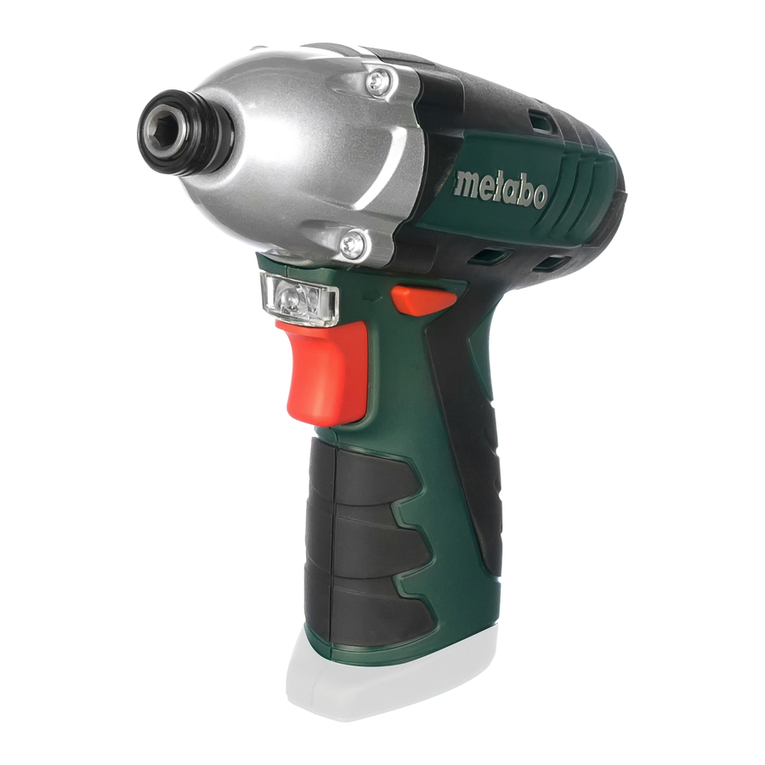TOOLSPACE XW-2001 User manual

20V CORDLESS DRILL
Model: XW-2001

Dear Customer,
Thank you for your purchase.
Your purchase means the world to us.
If you have any questions, we are here to service you.
lf the product you received is damaged or has quality
problems, please contact us through Email below and
attach product pictures of related problems,we will
reply to you as soon as possible,and provide you with
the best solution.
Email: TOOLSPACE01@outlook.com
Best regards,
Toolspace Customer Service Team

Do not discard electrical appliances with household waste.
CONGRATULATIONS ON YOUR PURCHASE OF OUR PRODUCT. This instruction manual is intended
primarily to familiarise the operator with safety, installation, operation, maintenance, product storage and
troubleshooting and it provides important information. So keep it well so that other users can information in the future
too. Due to the constant development and adaptation to the latest demanding EU standards, technical and optical changes
can be made to the products without prior notice. Photos and drawings in this instruction manual may only be illustrative.
Therefore, no legal claims related to this instruction manual, in particular any slight minor deviations from the information
contained therein, can be applied if the product continues to meet all of the above mentioned standards and
declarations, and works as described. In case of confusion, contact the importer or retailer.
Before the first operation, please read the owner’s manual carefully!
The battery contains toxic substances.
Please dispose of batteries at your local battery disposal depot.
IPX1
T3,15A
Do not store or use the battery in
locations where the temperature may reach or exceed 50°C!
Do not throw the battery into fire.
Do not throw the battery into water.
Do not throw the battery into household waste.

5
14
13


Features
Gear selector
Bit holder (magnc)
Rotonal direon switch/lock
ON/OFF switch/speed control
Bery charge level bon
Bery display LED
Bery pack
Release bn for bery pack
LED work light
Chuck
Torque selon ring
High-speed charger
Red charge control LED
Green charge control LED
Technical details
Cordless drill: XW-2001
Rated voltage: 20 V (DC)
Rated idle speed:
1st gear: n 00–400 rpm
2nd gear: n 0 0–1400 rpm
Chuck clamping
range : max. Ø 10 mm
Max. drill diameter:
Steel: 13 mm
Wood: 30 mm
Ba�ery: XW-200102C
Type: LITHIUM ION
Rated voltage: 20 V (DC)
Capacity: 2.0 Ah

Cells 5
High-speed baery charger: XZ2150-2400KT
INPUT:
Rated voltage: 120V~ , 50 Hz(AC)
Rated power consump
ti
ti
ti
tion: 65 W
OUTPUT:
Rated voltage: 21.5 V (DC)
Rated current: 2.4 A
Charging me: approx. 60 min.
Protec on class: II / (double insula on)
Noise emission value:
Noise measurement value determined in accordance with EN ISO 4817 The A-rated noise level of
the power tool is typically as follows:
Sound pressure level: L pA = 71 dB(A) Uncertainty K: K pA = 5 dB
Sound power level: L WA = 82 dB(A) Uncertainty K: K WA = 5 dB
Vibra�on emission value:
Total vibra�on values (vector total of three direc�ons) determined in accordance with EN 62841:
Drilling in metal: Vibra�on emission value
a h,D : 1.3m/s 2 Uncertainty K = 1.5 m/s2
NOTE
►The vibra�on level specified in these instruc�ons has been measured in accordance with the
standardised measuring procedure specified and can be used to make equipment comparisons.
The specified vibra�on emission value can also be used to make an ini�al exposure es�mate.
WARNING!
►The vibra�on level varies in accordance with the use of the power tool and may be higher than
the value specified in these instruc ons in some cases. Regular use of the electric tool in such a
way may cause the user to underes�mate the vibra�on. Try to keep the vib
r
a�on loads as low as
possible. Measures to reduce the vibra�on load are, e.g. wearing gloves and limi�ng the working
�me. Wherein all states of opera�on must be included (e.g. �mes when the power tool is
switched offand times where the power tool is switched on but running without load).
WARNING! Read all safety warnings designated by the symbol and
all instruons.
General Power Tool Safety Warnings

WARNING! Read all safety warnings, instructions, illustrations and
specifications provided with this power tool. Failure to follow all instructions listed below
may result in electric shock, fire and/or serious injury.
Save all warnings and instructions for future reference.
The term "power tool" in the warnings refers to your mains-operated (corded) power tool or
battery-operated (cordless) power tool.
1) Work area safety
a) Keep work area clean and well lit. Cluttered or dark areas invite accidents.
b) Do not operate power tools in explosive atmospheres, such as in the presence of
flammable liquids, gases or dust. Power tools create sparks which may ignite the dust or
fumes.
c) Keep children and bystanders away while operating a power tool. Distractions can
cause you to lose control.
2) Electrical safety
a) Power tool plugs must match the outlet. Never modify the plug in any way. Do
not use any adapter plugs with earthed (grounded) power tools. Unmodified plugs
and matching outlets will reduce risk of electric shock.
b) Avoid body contact with earthed or grounded surfaces, such as pipes, radiators,
ranges and refrigerators. There is an increased risk of electric shock if your body is earthed or
grounded.
c) Do not expose power tools to rain or wet conditions. Water entering a power tool
will increase the risk of electric shock.
d) Do not abuse the cord. Never use the cord for carrying, pulling or unplugging the
power tool. Keep cord away from heat, oil, sharp edges or moving parts. Damaged or entangled
cords increase the risk of electric shock.
e) When operating a power tool outdoors, use an extension cord suitable for
outdoor use. Use of a cord suitable for outdoor use reduces the risk of electric shock.
f) If operating a power tool in a damp location is unavoidable, use a residual current
device (RCD) protected supply. Use of an RCD reduces the risk of electric shock.
NOTE The term “residual current device (RCD)”can be replaced by the term “ground fault
circuit interrupter (GFCI)”or “earth leakage circuit breaker (ELCB)”.
3) Personal safety
a) Stay alert, watch what you are doing and use common sense when operating a
power tool. Do not use a power tool while you are tired or under the influence of
drugs, alcohol or medication. A moment of inattention while operating power tools may
result in serious personal injury.
b) Use personal protective equipment. Always wear eye protection. Protective
equipment such as a dust mask, non-skid safety shoes, hard hat or hearing protection used for
appropriate conditions will reduce personal injuries.
c) Prevent unintentional starting. Ensure the switch is in the off-position before
connecting to power source and/or battery pack, picking up or carrying the tool.
Carrying power tools with your finger on the switch or energising power tools that have the
switch on invites accidents.

d) Remove any adjusting key or wrench before turning the power tool on. A wrench
or a key left attached to a rotating part of the power tool may result in personal injury.
e) Do not overreach. Keep proper footing and balance at all times. This enables better
control of the power tool in unexpected situations.
f) Dress properly. Do not wear loose clothing or jewellery. Keep your hair and
clothing away from moving parts. Loose clothes, jewellery or long hair can be caught in
moving parts.
g) If devices are provided for the connection of dust extraction and collection
facilities, ensure these are connected and properly used. Use of dust collection can
reduce dust-related hazards.
h) Do not let familiarity gained from frequent use of tools allow you to become
complacent and ignore tool safety principles. A careless action can cause severe injury
within a fraction of a second.
4) Power tool use and care
a) Do not force the power tool. Use the correct power tool for your application. The
correct power tool will do the job better and safer at the rate for which it was designed.
b) Do not use the power tool if the switch does not turn it on and off. Any power tool
that cannot be controlled with the switch is dangerous and must be repaired.
c) Disconnect the plug from the power source and/or remove the battery pack, if
detachable, from the power tool before making any adjustments, changing
accessories, or storing power tools. Such preventive safety measures reduce the risk of
starting the power tool accidentally.
d) Store idle power tools out of the reach of children and do not allow persons
unfamiliar with the power tool or these instructions to operate the power tool.
Power tools are dangerous in the hands of untrained users.
e) Maintain power tools and accessories. Check for misalignment or binding of
moving parts, breakage of parts and any other condition that may affect the power
tool’s operation. If damaged, have the power tool repaired before use. Many
accidents are caused by poorly maintained power tools.
f) Keep cutting tools sharp and clean. Properly maintained cutting tools with sharp cutting
edges are less likely to bind and are easier to control.
g) Use the power tool, accessories and tool bits etc. in accordance with these
instructions, taking into account the working conditions and the work to be
performed. Use of the power tool for operations different from those intended could result in a
hazardous situation.
h) Keep handles and grasping surfaces dry, clean and free from oil and grease.
Slippery handles and grasping surfaces do not allow for safe handling and control of the tool in
unexpected situations.
5.Battery tool use and care
a) Recharge only with the charger specified by the manufacturer. A charger that is
suitable for one type of battery pack may create a risk of fire when used with another battery
pack.
b) Use power tools only with specifically designated battery packs. Use of any other
battery packs may create a risk of injury and fire.

c) When battery pack is not in use, keep it away from other metal objects, like
paper clips, coins, keys, nails, screws or other small metal objects, that can make a
connection from one terminal to another. Shorting the battery terminals together may
cause burns or a fire.
d) Under abusive conditions, liquid may be ejected from the battery; avoid contact.
If contact accidentally occurs, flush with water. If liquid contacts eyes, additionally
seek medical help. Liquid ejected from the battery may cause irritation or burns.
e) Do not use a battery pack or tool that is damaged or modified. Damaged or
modified batteries may exhibit unpredictable behaviour resulting in fire, explosion or risk of
injury.
f) Do not expose a battery pack or tool to fire or excessive temperature. Exposure to
fire or temperature above 130 °C may cause explosion.
NOTE The temperature „130 °C”can be replaced by the temperature „265 °F”.
g) Follow all charging instructions and do not charge the battery pack or tool
outside the temperature range specified in the instructions. Charging improperly or at
temperatures outside the specified range may damage the battery and increase the risk of fire.
6.Service
a) Have your power tool serviced by a qualified repair person using only identical
replacement parts. This will ensure that the safety of the power tool is maintained.
b) Never service damaged battery packs. Service of battery packs should only be
performed by the manufacturer or authorized service providers.
Drill Safety Warnings
1) Safety instructions for all operations
a) Wear ear protectors when impact drilling. Exposure to noise can cause hearing loss.
b) Hold the power tool by insulated gripping surfaces, when performing an
operation where the cutting accessory or fasteners may contact hidden wiring or its
own cord. Cutting accessory contacting a “live”wire may make exposed metal parts of the
power tools “live”and could give the operator an electric shock.
2) Safety instructions when using long drill bits
a) Never operate at higher speed than the maximum speed rating of the drill bit. At
higher speeds, the bit is likely to bend if allowed to rotate freely without contacting the
workpiece, resulting in personal injury.
b) Always start drilling at low speed and with the bit tip in contact with the
workpiece. At higher speeds, the bit is likely to bend if allowed to rotate freely without
contacting the workpiece, resulting in personal injury.
c) Apply pressure only in direct line with the bit and do not apply excessive
pressure. Bits can bend causing breakage or loss of control, resulting in personal injury.
For battery tools:
1) Instructions regarding battery charging, information regarding ambient temperature range for
tool and battery use and storage, and the recommended ambient temperature range for the

charging system during charging;
2) For a battery-operated tool intended for use with a detachable battery pack or a
separable battery pack: instructions indicating the appropriate battery packs for use, such as
by a catalog number, series identification or the equivalent;
3) Instructions indicating the appropriate charger for use, such as by a catalog number, series
identification or the equivalent.
4)For battery tools with integral battery: instruction, how the integral battery can be removed
safely from the tool after the tool’s end of life, and information about the type of battery such as
Li-Ion, NiCd and NiMH.
WARNING!
■Hold the power tool by the insulated gripping surfaces when performing an operation where
the screw or attached tool could come into contact with hidden wiring. Contact between the
screw or attached tool and a live wire may cause exposed metal parts of the power tool to
become live and give the operator an electric shock.
Safety guidelines for battery chargers
■This appliance may be used by children aged 8 years and above and by persons with limited
physical, sensory or mental capabilities or lack of experience and knowledge, provided that they
are under supervision or have been told how to use the appliance safely and are aware of the
potential risks. Children must not play with the appliance. Cleaning and user maintenance tasks
may not be carried out by children unless they are supervised.
The charger is suitable for indoor use only.
WARNING!
■To avoid potential risks, damaged mains cables should be replaced by the manufacturer or
the manufacturer’s customer service department or a similarly qualified person.
Before use
Charging the battery pack (see fig. A)
CAUTION!
►Always pull out the plug before you remove the battery pack ⑧from or connect the battery
pack to the charger.
■Never charge the battery pack⑧when the ambient temperature is below 10°C or above
40°C.
Connect the battery pack ⑧to the rapid battery charger ⑬(see Fig. A).
Insert the power plug into the socket. The control LED ⑭lights up red to indicate that the
appliance is charging.

The green control LED ⑮indicates that the charging process is complete and the battery
pack ⑧is ready.
Insert the battery pack ⑧back into the appliance (see Fig. B).
Attaching/disconnecting the battery pack to/from the appliance
Inserting the battery pack:
Push the rotation direction switch ③into the middle position (lock) (see Fig. C). Allow the
battery pack ⑧to click into the handle (see Fig. B).
Removing the battery pack:
Press the release button ⑨and remove the battery pack ⑧(see Fig. D).
Checking the battery charge level
Press the battery charge level button ⑥to check the charge level of the battery (see Fig. E).
The status/remaining charge will be shown on the battery display LED ⑦as follows:
GREEN/RED/ORANGE = maximum charge/performance
RED/ORANGE = medium charge/performance
RED = low charge –charge the battery
Changing tools
Your cordless drill has a fully automatic spindle lock .
When the motor is stopped, the power train locks so that the chuck ⑪can be opened by turning
it . After you have attached the desired tool and tightened it by turning the chuck , you
can continue working (see Fig. F). The spindle lock is automatically released when the motor
starts (ON/OFF switch ④pressed).
Torque selection ring/drill setting
You can set the torque using the torque selection ring ⑫(see Fig. G).
Select a low level for small screws or soft materials.
Select a high level for large screws, hard materials or removing screws.
Select the drill setting for drilling work by adjusting the torque selection ring ⑫to the
position (see Fig. H).
2 speed gearbox
CAUTION!
►Only operate the gear selection switch ①when the appliance is at a standstill. Otherwise the
appliance can be damaged.
In first gear (gear selector switch ①in position: 1) (see Fig. I)
you can reach a speed of approx. 400 rpm and a high torque. This setting is suitable for all
screwing jobs.
In second gear (gear selector switch ①in position: 2) (see Fig. J)
you can reach a speed of approx. 1400 rpm for carrying out drilling work.
Operation
Switching on and off
Switching on:
To start the appliance, press the ON/OFF switch ④and keep it pressed in (see Fig. K).
The LED work light ⑩lights up when the ON/OFF switch ④is depressed lightly or fully. This

allows for illumination of the work area in low lighting.
Switching off:
Release the appliance's ON/OFF switch ④to switch off the appliance.
Adjusting the rotational speed
The ON/OFF switch ④has a variable speed control. Pressing the ON/OFF switch ④lightly yields
a low speed. Increasing pressure increases the speed (see Fig. K).
NOTE
►The integrated motor brake ensures rapid stoppage.
Changing the direction of rotation
Change the direction of rotation by pressing the rotational direction switch ③towards the
left or right (see Fig. L).
Tips and tricks
Tip! This symbol indicates proper behaviour!
Before operation, check whether the screw or drill bit is correctly positioned, i.e. centred in
the
drill chuck.
Screw bits are labelled according to their dimensions and their shape. If you are uncertain,
always check whether the bit fits tightly in the screw head without any free play.
Torque:
Smaller screws/bits can be damaged if you set the torque or rotational speed too high.
Hard screw joints (in metal):
Particularly high torques occur, for example, in metal screw joints made using drive sockets.
Select a low rotational speed.
Soft screw joints (e.g. in soft wood):
Again, use a low rotational speed, to avoid e.g. damaging the surface of the wood upon
contact with the screw head. Use a countersink.
When drilling in wood, metal and other materials, observe the following:
Use a high speed for drill bits with small diameter and a low speed for drill bits with large
diameter.
Select a low speed for hard materials and a high speed for soft materials.
Secure or fasten the workpiece in a clamp or vice (if possible).
Mark the spot where you want to drill using a centre punch or nail. Select a low rotational
speed when starting.
Pull the rotating drill bit from the hole repeatedly to remove dust and chips and clear the
hole.
Drilling in metal:
Use a metal drill (HSS). For optimum results, cool the drill bit with cutting oil. Metal drill bits
can also be used to drill into plastics. Start with a 3 mm diameter drill bit and then increase the
size until the desired hole diameter is achieved.
Drilling in wood:
Use a wood drill with a lathe centre; for deep holes, use an auger bit; for large-diameter
holes, use a Forstner bit. Small screws can be screwed directly into soft wood.

Maintenance and cleaning
WARNING! RISK OF INJURY! Always switch the appliance off and remove
the battery before carrying out any work on the appliance.
The cordless drill is maintenance-free.
■The appliance must always be kept clean, dry and free from oil or grease.
■Never allow liquids to get into the appliance.
■Use a soft, dry cloth to clean the housing. Never use petrol, solvents or cleansers which can
damage plastic.
■If a lithium-ion battery is to be stored for an extended period, the charge level should be
checked regularly. The optimum charge level is between 50% and 80%. The optimum storage
environment is cool and dry.
NOTE
►Replacement parts not listed (such as batteries, switches) can be ordered via our service
hotline.
Table of contents
Other TOOLSPACE Power Screwdriver manuals
Popular Power Screwdriver manuals by other brands

Worcraft PROFESSIONAL
Worcraft PROFESSIONAL CD-12LiA instruction manual
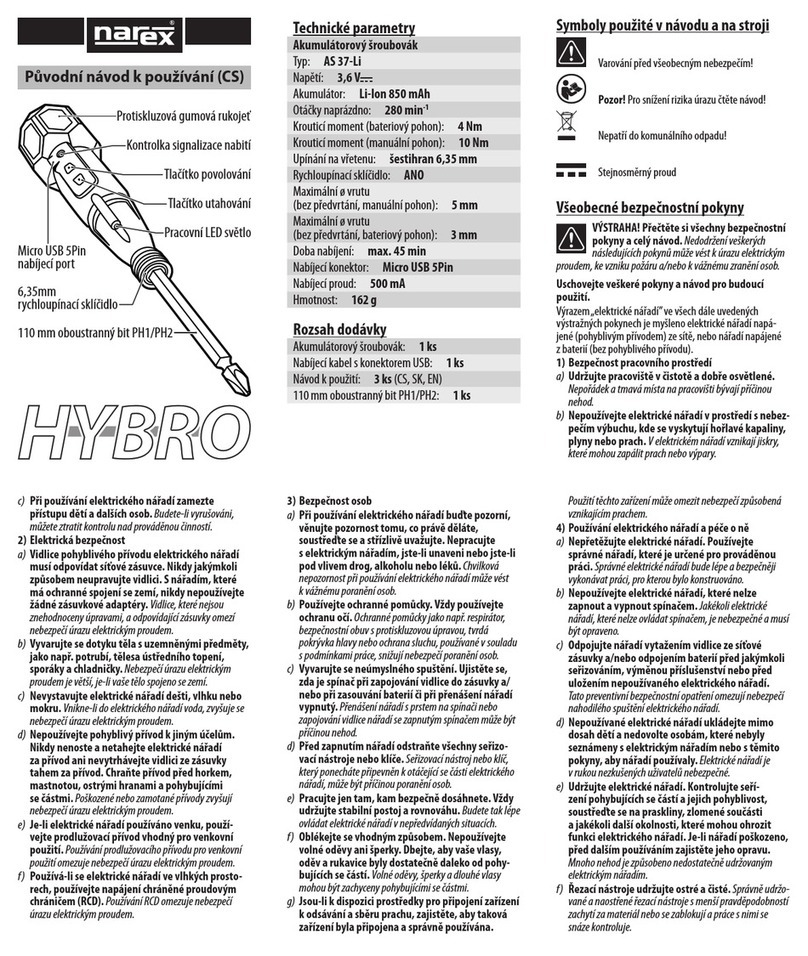
Narex
Narex AS 37-Li Original operating manual
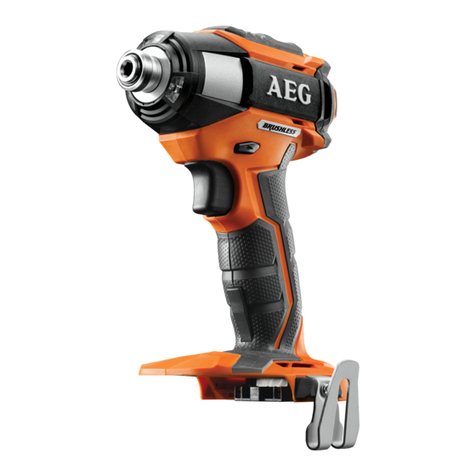
AEG
AEG BSS18CB3 Original instructions
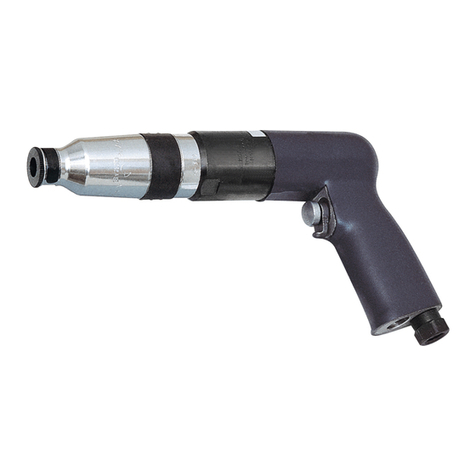
Ingersoll-Rand
Ingersoll-Rand 41PA8PSQ4 Product information

Bosch
Bosch GDR 120-LI Professional Original instructions
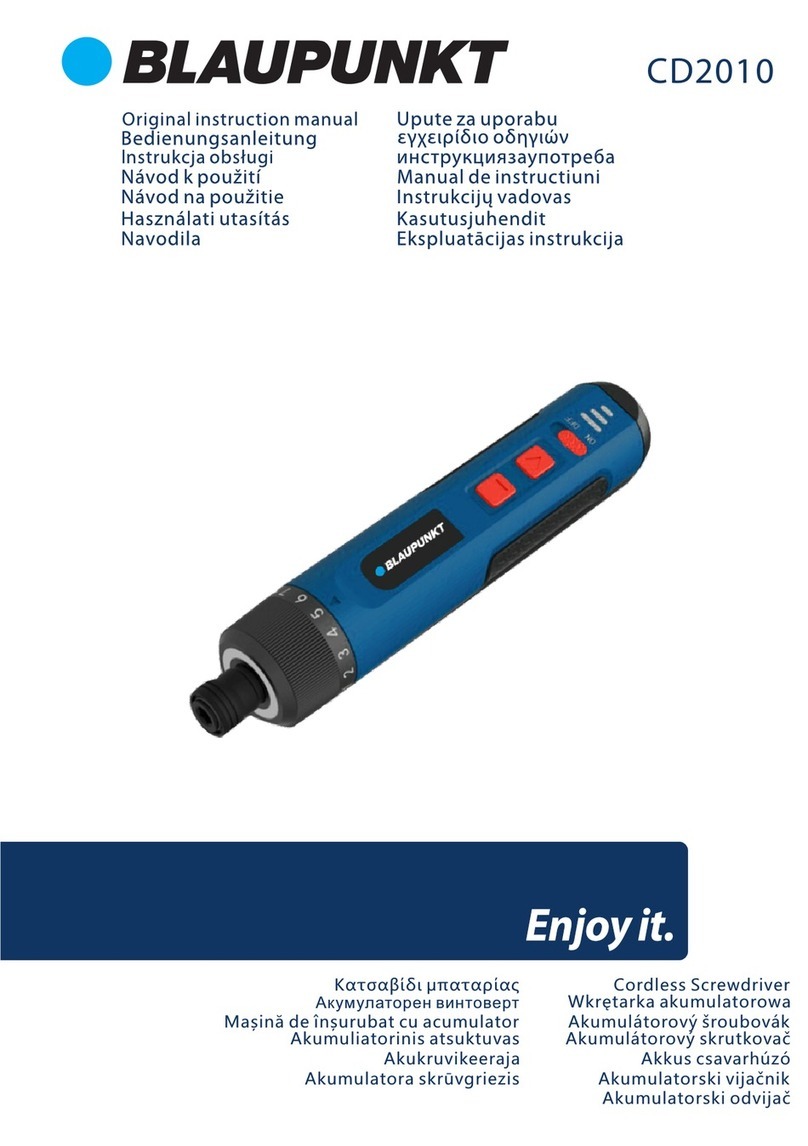
Blaupunkt
Blaupunkt CD2010 Original instruction manual
